
The biggest news today (January 17) is China’s population decline in 2022. Let’s talk about some of data and opinions surrounding this issue.
First, the data released by the National Bureau of Statistics on January 17 shows that the national population (including the population of 31 provinces, autonomous regions, municipalities directly under the Central Government and active military personnel, excluding residents of Hong Kong, Macao, Taiwan and foreigners living in 31 provinces, autonomous regions and municipalities directly under the Central Government) at the end of 2022 was 1,411.75 million, a decrease of 850,000 from the end of the previous year.
The annual birth population was 9.56 million, with a birth rate of 6.77‰; the death population was 10.41 million, with a death rate of 7.37‰; the natural population growth rate was -0.60‰.
I want to articulate a few thoughts about this data.
First: population decline will be a long-term trend, see the following table. After the founding of our country, the birth of the population surged, from 1949 to the mid-1990s. With the exception of a few years around the early60s, roughly 20 million people were born annually(in some years births exceeded 25 million), and China’s current average life expectancy is 78 years, and those born in 1949 will reach 78 years of age in 2027, even if we assume near-future increases in average life expectancy to 79 years, that means they’ll reach 2028.
The following chart shows the birth population data of Huang Wenzheng and Liang Jianzhang for all years (please note that the historical population statistics in China are often difficult to match precisely with various data sources, our main focus is the order of magnitude).
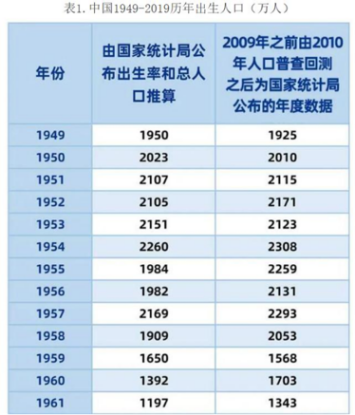
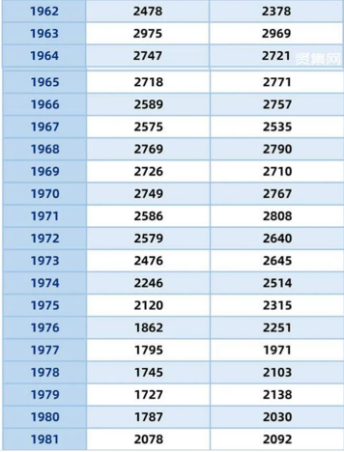
In other words, this year is 2023, the future of China’s death population will rapidly rise from the level of approximately 10 million people in 2022 (10.41 million deaths) to the level of 20 million people. In fact, this trend is easy to estimate without checking, China’s current population of 1.41 billion people, the average life expectancy of 78 years, the normal annual average number of deaths should be about 1.41 billion / 78 = about 18 million people, right. Now the number of deaths is only about 10 million people, because the peak birth population after the founding of the country has not yet withdrawn from society.
However, note that in 2022 only 9.56 million people will be born in China (convenient to remember that is about 10 million people), while the number of women of childbearing age (20-40 years old) is decreasing, so the number of births in China is tending to decrease, this increase and decrease means that the rate of population decline in the future will accelerate, 2022’s rate of only 850,000 people a year is too “mild”.
Let’s take a look at the chart below;

if women of childbearing age are defined as 20-40 years old, it means that in 2023, women born in 1982 will drop out of the childbearing age and women born in 2003 will enter the childbearing age. And how many people were born in 1982? According to the census data, there were 23.79 million births in 1982 and 13.73 million births in 2003, with women accounting for about half of the births, so it is clear that more women are dropping out of childbearing age than those entering it. Therefore, the total number of fertile women is on the decline.
In short, logically speaking, after the founding of the country in 1949, the country rapidly entered the era of 20 million births per year, while only 10.41 million people died in 2022 – because the average life expectancy reached 78.2 years – then simply corresponds to the pre-founding of the country People born around 1944 (note that it is roughly, after all, precise calculations will not be that simple) dropped out of society, while not as many people were born and survived each year pre-liberation as post-liberation.
So, on the one hand, the future of China’s annual death toll will rise from about 10 million to about 20 million; on the other hand, China’s annual births are only about 10 million. Moreover the total female population of childbearing age is still declining it will be very difficult for China to maintain 10 million births per year in the future, and improvement of the total fertility rate is urgently needed. Of course, there are fluctuations in the births from 2000-2020, which means that in some years the number of new women entering childbearing age will increase compared to the previous year, helping to boost the number of babies born that year. However such fluctuations do not mean that the 10 million births per year will increase to the same level as the number of deaths of up to 20 million per year. As the chart below shows, the births from 2002-2019 are basically between 13-17 million, with women still only accounting for half of that, with fluctuations of about 1-2 million. Therefore, the continued population decline is a certainty, and the reduction of only 850,000 people last year is just a starting point.
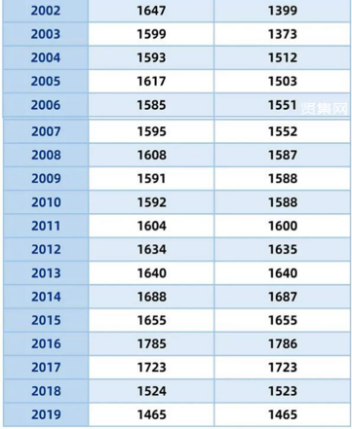
Second: the engineer bonus and population quality bonus
The so-called “engineer bonus” means that the population with higher education levels is still increasing, which can offset the population decline to a certain extent. The first large-scale expansion of college enrollment in China was in 1999, and the corresponding group was the population born in about 1981. Assuming a retirement age of 60, they will retire in 2041 (18 years from now), or retire in 2046 if retirement age is extended to 65 (23 years from now). From that perspective, the retirement time of the first batch of university students in China is about 20 years away from now. Considering that the number of recruits in the first few years of the expansion was not that large, it can be said that the engineer and population quality dividend has about 25 years to peak. After that time the absolute number of highly educated people in China will also decline, and do so more quickly.
At first glance this appears to be cause for relief. It turns out that the “engineer dividend” will not peak for more than 20 years. Therefore, even though the population started to decline in 2022, those currently exiting from society are mainly born in the 30s and 40s, not very strong in terms of education level or consumption ability, and have little impact on the overall economy. We also have 20 or 30 years of the “engineer dividend” that can be leverage. But this is not the case. Demographic change is a slow process, and we have to start acting now. Children born in 2023 will not enter the labor force until 22 years later – more than 2 decades down the road. If births are not encouraged now and the number of births is allowed to continue to decline, the highly educated population will also decline as fast as today in 20 years.
Some say that a shrinking population may not be a big deal. Our society has been way too competitive, wouldn’t a declining population leave us some breathing room? Some say China would be better off with only 800 million people, others even say it’s best to have only 300 or 400 million people like the United States. Well I think this idea exists because China’s geographic size, large population, & increasing national strength gave us a sense of security, and made us forget what kind of world we are in. We are in a world dominated by the US; the Anglo-Saxon nation occupies the top of the earth, it’s surrounded by allies such as the West and Japan,, & has a deep sense of racial & ideological hostility towards China and its social system.
As you read this article, U.S. military aircraft and warships are flying and sailing near our coast; their warships deliberately cross our Taiwan Strait and invade the territorial waters of our Spratly Islands several times a year. And now the United States is uniting with its European and Japanese allies to cut off the supply of advanced technology and products to China, and wants to completely suppress China to the low-end of the economic value chain. Fortunately, our huge domestic market has supported local companies to engage in localization, and is providing a steady stream of funds for it.
The reason we are so confident that our aggregate economic and national strength will surpass that of the US is because we have solved the problem of national organizational capacity, and our population is four times that of the US. Even if our technology, industry and efficiency are slightly inferior to those of the US, it does not affect the fact that our aggregate power will eventually exceed theirs, and is generally expected to reach twice that of the United States. As the top Anglo-Saxon nation in the world, the total births of the U.S., Canada, Britain, Australia and New Zealand in 2022 is about 5 million, and if you add their European allies’ 4 million births per year, their annual births are about 9 million people, already about the same as our annual births of about 10 million people, don’t forget that they also have Japan, South Korea, and our Taiwan region.
Since the number of annual births in China is already about the same as these countries combined, it means that our GDP per capita has to reach the average level of today’s developed countries in order for our aggregate economic power to be comparable to them. This is quite a difficult endeavor, isn’t it? And if our aggregate economic size is only equal, it will be difficult to maintain a clear advantage. What if China’s annual birth rate falls to 5 million in the future? Then it means that China’s GDP per capita has to be twice that of Europe and the United States, so as to be equal to them.
This is what I have been saying, China’s future is optimistic in the short to medium term, but the competition with the West will take centuries. Back in the day, we fought against the Xiongnu for several centuries to decide the outcome. I think the modern day West is even more difficult to deal with than the Xiongnu of our past. First, the Xiongnu were only powerful militarily, but technologically, economically and culturally weak. Second, the Xiongnu occupied a bitterly cold land, while today the West occupies Europe, North America, Australia and New Zealand – great places for human habitation. To compete with the United States and even the entire West, we need to be prepared for hundreds of years. In the future, I think that if China wants to win completely, it must expand its geographical presence in outer space, but this will be a hundred years in the future.
In addition to the total population, there is also a demographic issue. Even if our population is equal to that of the West, if our fertility rate is too low, the demographic structure is older and the burden of old age is heavier, then we’re less competitive. To put it simply , on your side, a working person needs to support two elderly people, while on their side, a working person only needs to support one elderly person. So who has more money to invest and consume? The older the population is, the less energetic and lifeless it becomes. Many villages, towns, and counties in China are like this now, with only old people left in the streets, while the big cities are full of young people and economic vitality.
To reiterate my point of view: China is now an industrialized and urbanized country. The population of industrialized countries is a non-renewable resource and will definitely decrease. This is a major premise, so under such a major premise:
1: It is meaningless to discuss the “appropriate population” level of China, whether it’s 1 billion, 800 million, or 600 million people, or to discuss the maximum carrying capacity of China’s land, whether it is 1.6 billion people or 2 billion people, etc. Because the population of industrialized countries will definitely continue to decrease until immigrants are introduced. Just like our age will definitely increase, and we are discussing what is the ideal age of a person? It doesn’t matter if you’re 18, 25, 35, or 45. Your age today will not be the same as next year.
2: Nowadays public policy is pivoting towards the encouragement of “more births”. When you hear these two words, don’t think of “rapid population growth”, “Isn’t China’s population large enough?”, “Isn’t there enough competition?” and so on. No matter how much encouragement is given to industrialized countries, the population will not increase. In fact, in countries that vigorously encourage more births, the fertility rate in Europe and the United States is 1.6-1.8%, and in East Asia, it is only 1.4%. We are currently talking about encouraging more births, so that the fertility rate in our country can be restored to 1.8%, which is already the pinnacle of industrialized countries in the world. In 2020, China’s fertility rate is 1.3%, and it is still falling. And I think given China’s current situation, don’t expect 1.8%. It should be compared with East Asia. Japan with a fertility rate of 1.4% is the pinnacle of East Asia, while places such as Taiwan, Hong Kong, South Korea, and Singapore that strongly encourage fertility are all less than 1.0% (Singapore is slightly higher than 1.0%, but that’s driven by ethnic minorities, whereas the Chinese community remains less than 1.0%). In other words, even if more births are encouraged, the population of our country will still decline, and do so rapidly, but a better fertility rate will lead to a higher level of pensions, allowing more Chinese people to dance in the square and travel abroad when they are old, instead of continuing to work in fast food restaurants or be an DiDi driver.
3: The population problem in non-industrialized countries is rapid population growth without access to education and jobs, while the population problem in industrialized countries is rapid population decline and deterioration of the population structure. Demographic problems are different in different stages of development. Our focus should change with the times. We must get rid of decades of family planning propaganda anchored in our minds that “only focus on total population and its bad consequences.” or “Chinese people are too fertile, and once birth control is liberalized or encouraged, they will have a lot of children.” Right now we have a problem of rapid population decline, not one of rapid population increase. In short, many of us are still talking about “Is there not enough people already?”, “How many people can China possibly carry?”, or “Do you want China to have 1.6 billion or 1.8 billion people?” These kinds of questions are out of touch with reality, because the population of industrialized countries is bound to decline.
We are currently on a downward slope, both in terms of total population and population structure. Encouraging more births is actually just putting on the brakes, which will not change the overall trend. What we should study is how to encourage childbirth, to optimize our aging demographic structure, and to prevent a drastic decline in population. Finally, I think that in the long run, the introduction of foreign labor into our country in the future is a certainty; there is no escape from the aging of the developed economies around the world. The entry of immigrants will cause a series of social problems. Of course, before that, in the next few years, a large number of measures to encourage and reward childbearing will be introduced across the country as a form of self-help. In fact, multiple locales have already announced rewards one after another, but the incentives vary in attractiveness. The chart below shows the incentives published in Jinan in January 2023, with a monthly childcare allowance of 600 yuan per child for each of the two and three children, plus an additional 200 yuan per month for those living in particularly difficult circumstances until the age of 3.
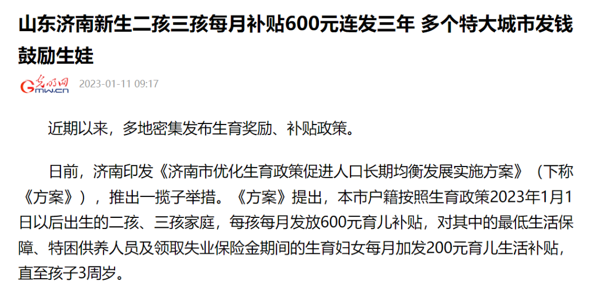
The chart below shows the incentives for childbirth issued by the Shenzhen Health Commission in January 2023: a three-year cumulative subsidy of 7,500 yuan for the birth of a child, a further three-year cumulative incentive of 11,000 yuan for the birth of a second child, and an additional three-year cumulative incentive of 19,000 yuan for the birth of a third child.
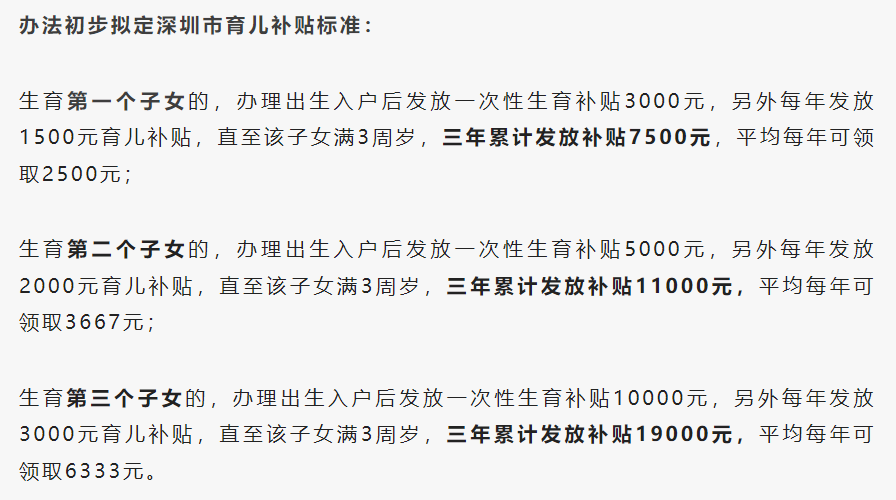
Generally speaking, it is a definite trend for our country to move towards promoting births in an all-round way. As mentioned above, Shenzhen and Jinan have recently introduced measures to directly reward cash for giving birth. Encouraging childbearing in an all-round way is a systematic project. In addition to rewarding cash, there are also childcare institution construction, education cost reduction, protection of working rights of childbearing women, protection of rights and interests of full-time housewives, social support for single-parent families, etc. In addition, I have always felt that the real estate policy should be adjusted. The population is declining, and the decline will accelerate in the future. We can consider moderately liberalizing the construction of villa communities and low-density communities in third-, fourth-, and fifth-tier cities to retain young people, and give young people housing choices among urban villages, apartment buildings, high-rise buildings in big cities, and single-family and garden houses in small and medium-sized cities or rural communities, instead of having them return to small and medium-sized cities and county towns just to find that there are still a bunch of high-rise buildings and residences -the exact same living environment as big cities. Birth rate in big cities is the lowest. This will not be change without housing changes.
In short, China is an excellent nation, still facing competition and suppression from the Anglo-Saxon-led West. Since industrialization has been achieved, the year of 2021 has marked the peak of our population since the founding of our nation, and an unprecedented peak at that. After this milestone, our main challenge will be one of how to preserve our precious, non-renewable, & declining human resources.





